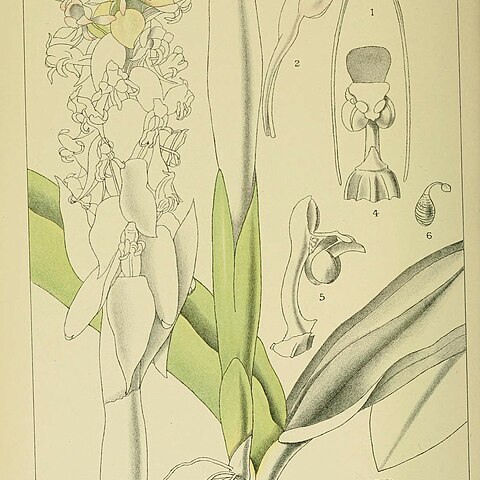Plants (170-) 260-530 (-810) mm tall; leaves 1 or 2, on a separate shoot next to the flowering stem, 40-200 mm long. Inflorescences lax, (3-) 12-35 (-60)-flowered; bracts narrowly ovate, 1.4-1.8 times the length of the 6-15 mm long ovary, strongly deflexed. Flowers white to pink, usually with deeper-coloured nerves, spurs and distal parts of sepals and petals tinged deep pink. Sepals free almost to the base and distally fairly sharply recurved. Petals forming with the sides of the lip a loose tube, then sharply deflexed. Lip with prominent puberulous apical flap; spurs 15-46 mm long. Viscidia elliptic and prominent; stigma very broadly obovate, emarginate, c. 2 mm tall; rostellum slightly longer than stigma, with appendix.
Plants terrestrial, robust, 0.17-0.81 m high. Leaves 1 or 2, radical, on sterile shoot, ovate-elliptic, spreading, 40-200 x 60-75 mm. Inflorescence lax, 12-60-flowered; bracts deflexed. Flowers white to pink, floral parts tinged pink, darker veins, petals dry to brown shortly after anthesis. Sepals free. Petals forming tube with sides of lip, sharply deflexed. Lip with prominent apical flap; spur 15-46 mm long. Flowering time Dec.-Feb.
Stout, tuberous geophyte to 80 cm. Leaves 1 or 2, ovate, on a separate shoot next to flowering stem, bracts deflexed. Flowers many in a lax raceme, white to pink and usually partly with pink tinge, spurs filiform, 15-46 mm long.
A slender herb. It is an orchid that grows in the soil. It grows 10-65 cm high. The leaves are on a separate sterile shoot. The leaves along the flowering stem sheath. The flowers are white. The tubers are 1-4 cm long and oval.
Column 6.5–9 mm high; stigma 2–3 × 2.5–4 mm; rostellum 2–3 mm long, the mid-lobe ± orbicular from a narrow base, much longer than side lobes.
Flowers scented, white, with pale pink spots at apices of lip and lateral sepals, sometimes whole flower tinged with pink or purple.
Lip 9–12 mm long, of similar width when spread out, very convex and hooded, wide-mouthed with the apex reflexed.
Sterile shoot 3–5-leaved; the lowermost 1–3 leaves sheathing; upper leaves up to 11 × 7.5 cm, ovate.
Median sepal 9–13 × 2–3 mm, oblong, obtuse; lateral sepals slightly longer and wider, oblique.
Fairly slender terrestrial herb 10–65 cm high; tubers 1–3.5 cm long, ellipsoid or ovoid.
Petals similar to median sepal but slightly shorter and wider, ciliolate at apex.
Sepals and petals deflexed, joined to each other and lip in basal quarter.
Bracts reflexed, up to 35 mm long at base of inflorescence.
Inflorescence 6–8 × 2–2.5 cm, laxly up to 15-flowered.
Flowering stem with 3–9 sheathing leaves c. 4 cm long.
Spurs 3.3–4.3(5) cm, slender, tapering.
Ovary and pedicel c. 10 mm long.

